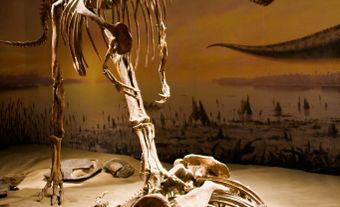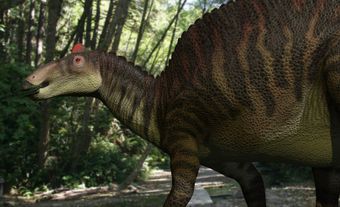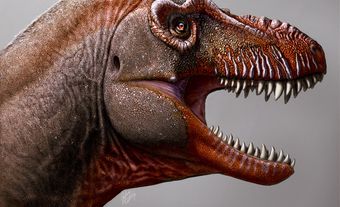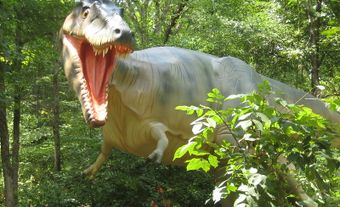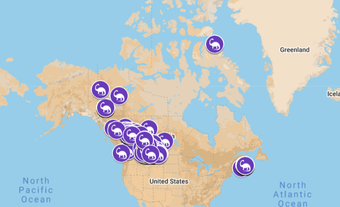Cryodrakon (pronounced CRY-oh-DRAH-kon) is a genus of giant pterosaur in the family Azhdarchidae. It lived toward the end of the Cretaceous period (76.5 million–74.8 million years ago) in southern Alberta. With a wingspan of at least 10 m — the equivalent of a small airplane — Cryodrakon was one of the largest flying animals ever known. It is also one of the first giant pterosaurs to have ever lived and the only pterosaur discovered in Canada.
What is a pterosaur?
A pterosaur (pronounced TER-oh-sore) is a flying reptile. They lived during the same period as dinosaurs, between about 230 million and 66 million years ago. Although pterosaurs are often called “flying dinosaurs,” they are only close relatives of dinosaurs. Contrary to dinosaurs, pterosaurs did not evolve into birds. Pterosaurs walked on all fours and possessed a membranous wing supported by a long fourth finger. In contrast, birds are small, two-legged, meat-eating dinosaurs. Their wings are formed by elongate feathers attached to their forelimbs.
Description
Paleontologists have only discovered a partial wing, a few leg bones, and several neck vertebrae belonging to Cryodrakon. However, its appearance can be reconstructed based on what paleontologists know about pterosaurs in general and about better known, closely related species. Cryodrakon belongs to a group of pterosaurs called azhdarchids, which includes some of the largest animals to have ever flown, like the better-known Quetzalcoatlus. All pterosaurs possessed membranous wings that stretched along the arm and an extremely long fourth finger. In many species, the wings connected to the hind foot, somewhat reminiscent of bats and flying squirrels. In large azhdarchids, however, the wings may have connected to the thigh or body instead. Pterosaur wings were stiffened by fibers embedded in the skin membrane.
The body and head of pterosaurs were covered with hair-like filaments, identical to the primitive feathers seen in theropod dinosaurs. These filaments kept the animal warm. The presence of a great variety of pigments in the skin and filaments of pterosaurs indicate they were colourful animals.

When on the ground or in trees, pterosaurs walked on all fours. The first three fingers of their hands touched the ground, the fourth finger was bent upward to hold up the wing membrane, and the four-toed feet rested flat on the ground. All digits, except for the fourth finger, had claws. Azhdarchids, and likely Cryodrakon, had relatively small padded and slender feet, suggesting they were adapted to walk on firm ground. When on the ground, Cryodrakon would have been as tall as a giraffe.
The most complete Cryodrakon specimen is a partial skeleton of an immature individual with a wingspan of about 5 m. However, a neck vertebra from a different individual is similar in size to that of the gigantic Quetzalcoatlus. This reveals that adult Cryodrakon had a wingspan of at least 10 m. Like Quetzalcoatlus, Cryodrakon may have had a small crest on its head. As with other azhdarchids, Cryodrakon had a long, shallow, straight beak, and no teeth.
Most paleontologists believe Cryodrakon weighed between 150 kg and 240 kg. However, others have estimated a mass as high as 350 kg to 544 kg.
Range and Habitat
Cryodrakon lived on the western coastal plain of the Western Interior Seaway, an inland sea that connected the modern-day Arctic Ocean to the Gulf of Mexico, dividing North America in two. The fact that azhdarchid remains are mostly found in terrestrial deposits rather than coastal or marine settings suggests they preferred to live inland, far from the sea. Although paleontologists have only found Cryodrakon fossils in southern Alberta, the large size and aerodynamic properties of giant azhdarchids suggest these animals could have flown nonstop for thousands of kilometres. This raises the possibility that these animals may have had continent-wide or even intercontinental ranges.
Reproduction and Development
While paleontologists have never found Cryodrakon eggs or embryos specifically, they have discovered the eggs and embryos of other pterosaur species. Pterosaurs laid elongate, soft-shelled eggs, similar to some lizards and turtles. Like crocodiles, pterosaurs likely buried their eggs in a humid substrate, like soil or vegetation mounds, to incubate them.
Diet
Like all pterosaurs, Cryodrakon was carnivorous. However, little is known about its diet. With shallow, straight jaws and small jaw muscles, azhdarchids had weak bites. They likely fed on small prey and did not subdue large, struggling animals. Their toothless, chopstick-like jaws were likely used to pluck and seize small animals (e.g., fishes, amphibians, reptiles, maybe small dinosaurs) off the ground or shallow waters and to swallow them whole. As such, Cryodrakon may have behaved like a giant stork.
Behaviour
Although some pterosaurs were gregarious and lived in colonies, little is known about the behavior of Cryodrakon or azhdachids in general. This is because their fossil remains are rare and incomplete. Some paleontologists suggest that giant azhdarchids may have been solitary but that smaller azhdarchids may have been gregarious.
Despite their large size, most paleontologists believe that giant azhdarchids were capable of flight. To take off from the ground, pterosaurs vaulted themselves forward with their powerful forelimbs and actively flapped their wings to gain altitude, similar to ground-based vampire bats. However, some paleontologists think they may have pushed themselves upwards using their hindlimbs, more like birds. Given their sheer size, it is unlikely that giant azhdarchids were continuously flapping their wings to fly. Instead, they likely used columns of warm air to soar through the skies, similar to albatrosses and vultures. Because of its strong forelimbs, Cryodrakon was better adapted for rapid launch and burst flight and less for soaring than Quetzalcoatlus.
Did you know?
Because pterosaur bones are very thin (typically 1 mm), they are fragile and break easily. Hence, the odds of pterosaur bones getting buried, fossilized and discovered intact are extremely low. This is why pterosaur skeletons are so rare and are usually preserved under exceptional conditions (e.g., fine-grained marine or lake deposits). However, there is little doubt that pterosaurs were common during the Age of the Dinosaurs in Canada and around the world.
Discovery
A member of the public, Olafur Johnson, discovered the first pterosaur bone from Canada. Johnson made his discovery (a partial fourth finger), around 1972 in the Dinosaur Park Formation of Dinosaur Provincial Park in southern Alberta. In the decades that followed, additional isolated pterosaur bones were discovered in the same area and elsewhere in the province. In 1992, Wendy Sloboda, a technician working at the Royal Tyrrell Museum of Paleontology, discovered the most complete pterosaur skeleton in Canada, consisting of a partial wing, a few leg bones, and several neck vertebrae, in Dinosaur Provincial Park. Although it was initially considered to be a species within the genus Quetzalcoatlus, in 2019 a team of paleontologists studied the specimen in detail and recognized that it, and all other pterosaur bones discovered in the Dinosaur Park Formation, were from a different type of pterosaur. They gave it the name Cryodrakon boreas, which means “frozen dragon from the north winds.” The name is a reference to Canada, though the climate was subtropical at the time Cryodrakon lived.

 Share on Facebook
Share on Facebook Share on X
Share on X Share by Email
Share by Email Share on Google Classroom
Share on Google Classroom

